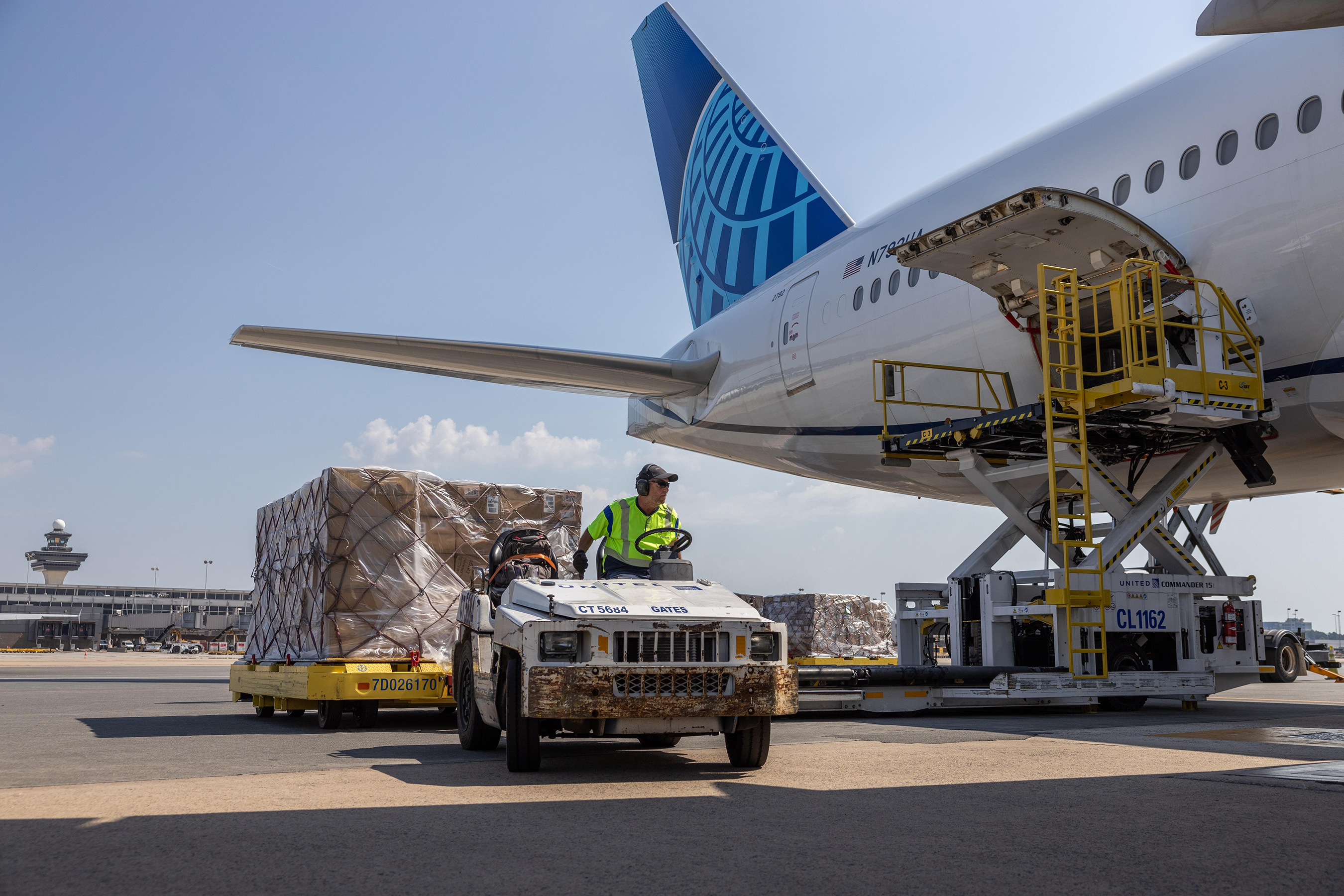The Next Cargo Gateway?
Strategic cargo play could make Washington Dulles International Airport Virginia’s next step to logistics dominance
It’s not the first time Washington Dulles International Airport, having served record numbers of passengers the past two years, has eyed an expansion of its operations, infrastructure, and ultimately, air cargo volume.
But this time, circumstances are different. This favorable environment is owed in part to Virginia’s other puzzle pieces falling into place, such as the massive $1.4 billion modernization effort completed at The Port of Virginia that could help grease the wheels of Dulles’ cargo rollers. And then there’s the $7 billion already being pumped into the Northern Virginia passenger hub, thanks to a newly negotiated airline agreement, which opens the door for significant infrastructure projects to roll out over the next 15 years.
These momentum boosters include a future fifth airport runway and a $700 million United Airlines concourse slated to open in 2026. Each of these strategic upgrades carries an upside to organically boost the planned cargo expansion.
“With an increasing volume of flights and passengers, there’s an opportunity at a minimum for additional belly cargo,” said Thomas Beatty, Metropolitan Washington Airports Authority (MWAA) executive vice president and chief operating officer.
Translation: With the coming surge in passenger flight capacity, your checked bag could be stowed in the same airplane belly as a load of fast-fashion merchandise that needs to arrive before the next TikTok trend goes viral.
And that’s just one way Dulles’ passenger flight wins can easily translate to cargo wins.
“I think the other big thing is that we just updated the Washington Dulles International Airport Master Plan,” Beatty said. That comprehensive vision for the airport’s next 20 to 25 years is currently on its way to the Federal Aviation Administration for review.
“Dulles is in the strongest position in its history,” Beatty added.
Built-In Advantages
These developments are additives for the fresh fuel in what’s been a sustained cargo gateway play for Dulles. The airport has grown its cargo haul over six decades to more than 300,000 tons annually. But while the airport is collecting and dispersing cargo as far as Ohio, Pennsylvania, New York, Connecticut, and the Carolinas, its total still pales to that of international competitors John F. Kennedy in New York (1.7 million tons), Newark (711,000), and Philadelphia (524,000).
Dulles already has a trove of built-in advantages that have helped it evolve into a thriving passenger airline hub with 46 airlines serving 160 nonstop international destinations. These include a strategic location that’s within a 24-hour drive of 70% of the U.S. population, a moderate climate, and the airport’s proximity to the Capital Beltway (Interstates 95 and 495), as well as I-270, I-66, I-81, and Route 15.
Additionally, Dulles’ sprawling 12,000-acre real estate treasure puts it in rarefied air not just along the East Coast, but across the globe. As other airports’ cargo facilities are increasingly cramped for space, the global demand for air cargo capacity saw double-digit growth in 2024, further raising the volume on Dulles’ air cargo conversation.

Washington Dulles International Airport
“It’s always been a part of the conversation,” said Scott York, executive director of the Committee for Dulles, a nonprofit corporation that promotes the economic vitality of Dulles and its environs, and former chairman of the Loudoun County Board of Supervisors. “We’ve discussed this topic off and on during my time on the Board. I think the opportunity of getting cargo there is much closer than in the past.”
The obstacles are twofold, but steep nonetheless: growing cargo-handling capabilities while enticing Virginia’s businesses to warm up to Dulles even more. So the Committee for Dulles held a joint meeting of its Legislative and Transportation & Economic Development committees, where a discussion took place among key stakeholders and decision-makers for the state, the airport, and other agencies.
Asking the Right Questions
Not long after this meeting of the minds, a feasibility study of Dulles’ path to a cargo gateway was undertaken. It sought to explore three questions, the answers to which would set the flight plan for subsequent workstreams:
- Is there enough cargo market share over the next five to 10 years to pursue expansion? Yes.
- Does Dulles currently have the capacity and infrastructure to attract more demand? Not exactly, but it’s a little more complicated than that.
- If the answers to questions 1 and 2 are “Yes,” does the project substantially matter to the Commonwealth? Yes, once a couple of the wrinkles in question 2 are ironed out.
Global air cargo consulting firm Rotate was charged with answering these questions, warts and all. “I think there are a lot of good things happening at Dulles,” said Ryan Keyrouse, the firm’s co-founder and CEO. “I was really surprised at what I found.”
The study also identified opportunities for cargo at the airport, including that local exports were bypassing Dulles. This freight in an area’s local footprint is known as an airport’s “catchment,” and when it loses cargo in its backyard, it’s known as “leaking.” Dulles was found to be leaking about half its catchment of exports as freight forwarders and logistics companies consolidated cargo at out-of-state airports as far away as Chicago to capitalize on economies of scale.
The study also found that Dulles was nearly running at its capacity for cargo — with some nuanced exceptions that could be among the first dominoes to fall along the road to expansion.
For example, while wide-bellied passenger aircraft arrived at Dulles from European departure points operating nearly at full capacity, return flights were far emptier — providing low-hanging-fruit space that could quickly accelerate momentum for Dulles’ cargo play.
“Quick wins will get them a little bit farther down the road,” Keyrouse said. “They’re connected to capitals all over the world with wide-bodied capacity.”
One other finding? While these passenger flights offered a golden ticket for cargo, it only pertained to certain cargo. Dulles was found to underperform when it came to sensitive or even dangerous materials requiring more high-maintenance transport.
Ready for Launch
The Dulles study didn’t just reveal potential opportunities to leverage and challenges to thwart en route to the airport’s ascension to becoming a cargo gateway. It also created several big boxes that the team of airport, state, and regional leaders will need to check, including:
- Scoring quick wins, including effectively defending their cargo catchment, securing anchor tenants, and hiring dedicated subject matter experts to lead the team forward
- Making short-term gains, including improved handling facilities and increasing storage capacity in efficient, cost-effective ways
- Engaging the entire ecosystem with the story about why transforming Dulles into a cargo gateway just makes sense: freight forwarders, potential neighboring manufacturers, and the global cargo community
And of course, there’s also unfettered, transparent collaboration, which is table stakes in the air cargo industry. Keyrouse suggested that the team-building infrastructure ultimately charged with building the cargo infrastructure nailed this down from the get-go.
From there, it’s a balancing act on a massive scale, not just when and where to spend, commit, and collaborate, but also how to optimally build out the infrastructure that will support the increased cargo volume.
To that point, Beatty cited the deep analysis being conducted in line with the Washington Dulles International Airport Master Plan to find the “Goldilocks zone” between eliminating gridlock and avoiding empty buildings.
Much of the effort to transform Dulles into a cargo gateway depends on being able to leverage the highly successful growth mindset, proven experience, and problem-solving savvy demonstrated from the passenger side of commercial aviation to the cargo side.
“We’re here to solve problems,” said Beatty, who pointed to airport leadership’s high-profile string of recent wins. “We’re open and transparent. We work with many airlines, many tenants, many concessions.”
And then there are also reasons why it needs to happen. Leading the list is that Virginia’s core industries require more and often specialized cargo capabilities, whether that means biopharmaceuticals, aerospace and defense, or advanced materials. These are industries that necessitate specialized air cargo considerations, from cold storage to heightened security.
And that’s perhaps the most telling microcosm for stakeholders looking to elevate cargo at Dulles: building the right infrastructure to support the right business at the right time, investment by investment, milestone by milestone.
At the end of the day, the idea of a major cargo gateway at Dulles isn’t just a pitch to the community of cargo decision-makers, global markets, or even the people of Virginia and beyond. Or a swing at an upper-deck expansion. It’s a promise to continue making Virginia the best partner it can possibly be, to everyone.
“I see a lot more enthusiasm because of the possibilities being more real now,” York said. “I think the study helped cement that opportunity. Not only in the minds of those outside the airport, but also those inside.”


